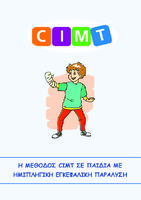| dc.contributor.advisor | Μπακαλίδου, Δάφνη | |
| dc.contributor.author | Μαμαλάκη, Ελευθερία | |
| dc.contributor.author | Χατζηνικολάου, Παρασκευή | |
| dc.date.accessioned | 2021-07-15T09:02:51Z | |
| dc.date.available | 2021-07-15T09:02:51Z | |
| dc.date.issued | 2021-07-12 | |
| dc.identifier.uri | https://polynoe.lib.uniwa.gr/xmlui/handle/11400/789 | |
| dc.identifier.uri | http://dx.doi.org/10.26265/polynoe-640 | |
| dc.description.abstract | Η εγκεφαλική παράλυση είναι η πιο κοινή παιδιατρική σωματική αναπηρία. Για την αποκατάσταση των ατόμων που έχουν διαγνωσθεί με αυτή, έχουν αναπτυχθεί, με την πάροδο του χρόνου, ποικίλες μέθοδοι. Μία από αυτές είναι η Εξαναγκαστικά Προκαλούμενη Κινητική Θεραπεία ή αλλιώς CIMT.
Στο πρώτο κεφάλαιο παρατίθενται πληροφορίες σχετικά με την Εγκεφαλική Παράλυση. Συγκεκριμένα γίνεται αναφορά στον ορισμός της, στα αίτια που μπορούν να οδηγήσουν σε αυτή, στο παθοφυσιολογικό υπόβαθρό της, στα επιμέρους είδη που ταξινομείται αλλά και στις μέχρι τώρα εφαρμοζόμενες θεραπείες.
Στην συνέχεια στο δεύτερο κεφάλαιο ορίζεται η θεραπεία CIMT ενώ ταυτόχρονα διατυπώνεται ο στόχος της αλλά και οι αρχές στις οποίες βασίζεται. Ακόμα, γίνεται αναδρομή στις πρώτες εργαστηριακές μελέτες σε πειραματόζωα, που έθεσαν τις βάσεις της θεραπείας CIMT έως τις πρώτες εφαρμογές αυτής στον παιδιατρικό πληθυσμό. Στην τελευταία ενότητα παρουσιάζονται τα είδη του CIMT που εντοπίστηκαν αρθρογραφικά.
Στον τρίτο κεφάλαιο γίνεται εκτενής αναφορά στην παιδιατρική εφαρμογή του CIMT. Αρχικά, δίνεται έμφαση στα χαρακτηριστικά που την διαφοροποιούν από την εφαρμογή της στους ενήλικες. Επιπλέον, απαριθμούνται και αναλύονται τα κριτήρια ένταξης των παιδιών στην θεραπεία καθώς και οι παράμετροι που διαμορφώνουν το πρωτόκολλο. Στις επόμενες δύο ενότητες προσδιορίζονται οι θεραπείες με τις οποίες βρέθηκε να έχει συνδυαστεί το P – CIMT αλλά και ο ρόλος της οικογενείας κατά την διεξαγωγή της παρέμβασης.
Στο τέταρτο κεφάλαιο παρουσιάζονται τα εργαλεία αξιολόγησης, τα οποία έκαναν χρήση οι μελέτες που συμπεριλήφθηκαν στην παρούσα ανασκόπηση, αλλά και τα χρονικά σημεία στα οποία εφαρμόστηκαν. Έπειτα, γίνεται λόγος για την αποτελεσματικότητα της θεραπείας CIMT στην αποκατάσταση του ημιπληγικού άνω άκρου, μέσω της συγκέντρωσης των μετρήσεων όλων των ερευνών. Παρουσιάζονται οι αλλαγές που επιφέρει στο κεντρικό νευρικό σύστημα αλλά και τα κέρδη στους τομείς που καθορίζουν την λειτουργικότητα του μέλους. Τέλος καταγράφονται τα διεξαγόμενα συμπεράσματα αλλά και οι προτάσεις για μελλοντική έρευνα. | el |
| dc.format.extent | 95 | el |
| dc.language.iso | el | el |
| dc.publisher | Πανεπιστήμιο Δυτικής Αττικής | el |
| dc.rights | Αναφορά Δημιουργού - Μη Εμπορική Χρήση - Παρόμοια Διανομή 4.0 Διεθνές | * |
| dc.rights | Attribution-NonCommercial-NoDerivatives 4.0 Διεθνές | * |
| dc.rights.uri | http://creativecommons.org/licenses/by-nc-nd/4.0/ | * |
| dc.subject | Children | el |
| dc.subject | Hemiplegia | el |
| dc.subject | Rehabilitation | el |
| dc.subject | Eγκεφαλική Παράλυση | el |
| dc.subject | Παιδιά | el |
| dc.subject | Ημιπληγία | el |
| dc.subject | Άνω άκρο | el |
| dc.subject | Constrained induced movementh therapy | el |
| dc.subject | Cerebral palsy | el |
| dc.subject | Upper extremity | el |
| dc.title | Η μέθοδος CIMT σε παιδιά με ημιπληγική Εγκεφαλική Παράλυση | el |
| dc.title.alternative | Method CIMT in children with hemiplegic Cerebral Palsy | el |
| dc.type | Πτυχιακή εργασία | el |
| dc.contributor.committee | Κομπότη, Αικατερίνη | |
| dc.contributor.committee | PAPADOPOULOU, MARIANNA | |
| dc.contributor.faculty | Σχολή Επιστημών Υγείας & Πρόνοιας | el |
| dc.contributor.department | Τμήμα Φυσικοθεραπείας | el |
| dc.description.abstracttranslated | Cerebral palsy is the most common pediatric physical disability. A variety of methods have been developed over time to rehabilitate people diagnosed with it. One of them is Constrained Induced Movement Therapy or CIMT.
The first chapter provides information on Cerebral Palsy. Specifically, reference is made to its definition, the causes that can lead to it, its pathophysiological background, the individual species that it is classified and also the treatments applied until now.
To continue, in the second chapter the CIMT treatment is defined while at the same time both its goal and the principles which is based on, are put forward. There is also a throwback of the first laboratory studies on experimental animals, which laid the foundations of CIMT therapy until its first applications on the pediatric population. The last section presents the types of CIMT that have been identified in articles.
The third chapter makes an extensive reference to the pediatric application of CIMT. Initially, emphasis is placed on the characteristics that differentiate it from its application on adults. In addition, the children’s inclusion criteria in the treatment are listed and analyzed, as well as the parameters that shape the protocol. The next two sections identify the treatments which were found to be combined with P - CIMT and the role of the family in carrying out the intervention.
The fourth chapter presents the evaluation tools, which were used by the studies included in this review, as well as the time points at which they were applied. Then, the effectiveness of CIMT therapy in the rehabilitation of the upper hemiplegic limb is discussed, through the collection of measurements of all studies. The changes it brings to the central nervous system are presented, as well as the gains in the areas that determine the functionality of the extremity. Finally, the resulting conclusions and the proposals for future research are noted. | el |


